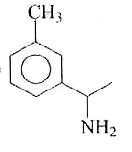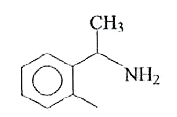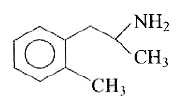The compound C5H13N is optically active and reacts with HONO to give C5H11OH. The compound is
2-amino pentane
N-methyl butanamine
N,N-Dimethyl propanamine
1- amino pentane
The correct Answer is:A
To solve the problem, we need to determine the compound with the molecular formula C5H13N that is optically active and reacts with nitrous acid HONO to yield C5H11OH.
Step 1: Identify the type of amine
The compound C5H13N is an amine. Given that it is optically active, it must have a chiral center. A chiral center is typically a carbon atom bonded to four different groups.
Step 2: Determine possible structures
We need to consider the possible structures of C5H13N that could contain a chiral carbon. The options provided are:
1. 2-Aminopentane
2. N-Methylbutanamine
3. N,N-Dimethylpropanamine
4. 1-Aminopentane
Step 3: Analyze each option for chirality
1. 2-Aminopentane: The structure is:
CH3−CH(NH2)−CH2−CH2−CH3
The carbon atom at position 2 is bonded to NH2, CH3, CH2−CH2−CH3 (the rest of the pentane chain), and H. This carbon is chiral.
2. N-Methylbutanamine: The structure is:
CH3−CH2−CH(NH2)−CH3
The nitrogen is bonded to a methyl group and the butane chain, but the carbon with the amine group is not chiral.
3. N,N-Dimethylpropanamine: The structure is:
CH3−CH(N(CH3)2)−CH2−CH3
The carbon with the amine group is not chiral since it has two identical methyl groups attached.
4. 1-Aminopentane: The structure is:
NH2−CH2−CH2−CH2−CH3
The amine is at the terminal position, and there is no chiral center.
Step 4: Determine the reaction with nitrous acid
The reaction of a primary amine with nitrous acid HONO typically yields an alcohol. Since 2-aminopentane is a primary amine, it will react with HONO to form 2-hydroxypentane:
C5H13N+HONO→C5H11OH+N2+H2O
Conclusion
The only compound that meets all the criteria (optically active, primary amine, and reacts with nitrous acid to form an alcohol) is 2-aminopentane.
Final Answer
The compound is 2-aminopentane.
---
The compound C5H13N is an amine. Given that it is optically active, it must have a chiral center. A chiral center is typically a carbon atom bonded to four different groups.
We need to consider the possible structures of C5H13N that could contain a chiral carbon. The options provided are:
1. 2-Aminopentane
2. N-Methylbutanamine
3. N,N-Dimethylpropanamine
4. 1-Aminopentane
1. 2-Aminopentane: The structure is:
CH3−CH(NH2)−CH2−CH2−CH3
The carbon atom at position 2 is bonded to NH2, CH3, CH2−CH2−CH3 (the rest of the pentane chain), and H. This carbon is chiral.
CH3−CH2−CH(NH2)−CH3
The nitrogen is bonded to a methyl group and the butane chain, but the carbon with the amine group is not chiral.
CH3−CH(N(CH3)2)−CH2−CH3
The carbon with the amine group is not chiral since it has two identical methyl groups attached.
NH2−CH2−CH2−CH2−CH3
The amine is at the terminal position, and there is no chiral center.
The reaction of a primary amine with nitrous acid HONO typically yields an alcohol. Since 2-aminopentane is a primary amine, it will react with HONO to form 2-hydroxypentane:
C5H13N+HONO→C5H11OH+N2+H2O
The only compound that meets all the criteria (optically active, primary amine, and reacts with nitrous acid to form an alcohol) is 2-aminopentane.
The compound is 2-aminopentane.
Topper's Solved these Questions
- AMINESBOOK - VMC MODULES ENGLISHCHAPTER - AMINESEXERCISE - ILLUSTRATION
25 Videos
- AMINESBOOK - VMC MODULES ENGLISHCHAPTER - AMINESEXERCISE - SOLVED EXAMPLES
21 Videos
- AMINESBOOK - VMC MODULES ENGLISHCHAPTER - AMINESEXERCISE - EFFICIENT
49 Videos
- ALDEHYDES,KETONES & CARBOXYLIC ACIDS BOOK - VMC MODULES ENGLISHCHAPTER - ALDEHYDES,KETONES & CARBOXYLIC ACIDS EXERCISE - IN-CHAPTER EXERCISE-M
10 Videos
- ATOMIC STRUCTUREBOOK - VMC MODULES ENGLISHCHAPTER - ATOMIC STRUCTUREEXERCISE - JEE Advanced (Archive )
67 Videos
Similar Questions
An organic compound 'A'(C4H10O) is optically active. On mild oxidation, it gives a compound 'B'(C4H8O) but upon vigorous oxidation, it gives another compound 'C'(C3H6O2). The compound 'C' along with 'D' are also formed from 'B' by reacting with iodine in the presence of alkali. Deduce the structures of 'A','B','C' and 'D'.
View SolutionA compound (C5H8) reacts with ammoniacal AgNO3 to give a white precipitate and reacts with excess of KMnO4 solution to give (CH3)2CH−COOH. The compound is
View Solution
Knowledge Check
Compound [X]C4H11N reacts with p− toluene sulphonyl chloride in aqueous NaOH to give a solid. The compound [X] is :
ACH3−CH2−CH2−CH2−NH2BH3C−C∣CH3H−CH2−NH2CCH3CH2−NH−CH2−CH3DH3C−CH2−N∣CH3−CH3An organic compound (A)C9H13N dissolves in dil. HCl and releases N2 with HNO2 giving an optically active alcohol. Alcohol on oxidation gives dicarboxylic acid, which on beating form anhydride. The organic compound 'A' is :
A B
B C
C D
D
When H2 is added to two isomeric alkenes A and B having molecular formula C5H9Cl, A gives optically inactive compound while B gives a chiral compound. The two isomers are
View SolutionA symmetrical organic compound of C4H11N give yellow oily layer on treatment with HNO2 then find the structure of the compound.
View SolutionAn organic compound (A) C4H9Cl on reacting with aqueous KOH gives (B) and on reaction with alcoholic KOH gives (C ), which is also formed on passing the vapours of (B) over the heated copper. The compound (C ) readily decolourises bromine water. Ozonolysis of (C ) gives two compounds (D) and (E ). Compound (D) reacts with NH2OH to give (F) and compound (E ) reacts with NaOH to have an alcohol (G) and sodium salt (H) of an acid. (D) can also be prepared form propyne on treatment with water in the presence of Hg2+ and H2SO4. Identify (A) to (H) with proper reasoning.
View SolutionAn optically active compound [A] C5H13N reacts with alkaline CHCl3 to give an optically active, compound [B]. [A] also reacts with nitrous acid to give an optically inactive alcohol [C] C5H11OH as the major product. What would be the structure of [A]?
View SolutionA+CS2+HgCl2 give C2H5−N=C=S. Thus compound
A is :-
View SolutionThe compound C8H9Cl(A) on treatments with KCN followed by hydrolysis gives C9H10O2(B).Ammonium salt of B on dry distillation yields C.Which reacts with alkaline solution of bromine to gives C8H11N.(D),Another compound E (C6H10O) is obtained by the action of nitrous acid on D. or by the action of aquouspotash on A,E on oxidation gives F(C8H10O) Which gives the inner anhydride G on heating. The compound D is reaction with CHCl3+NaOH gives a compound H.
The compound A on reaction with AgCN gives :
View Solution
